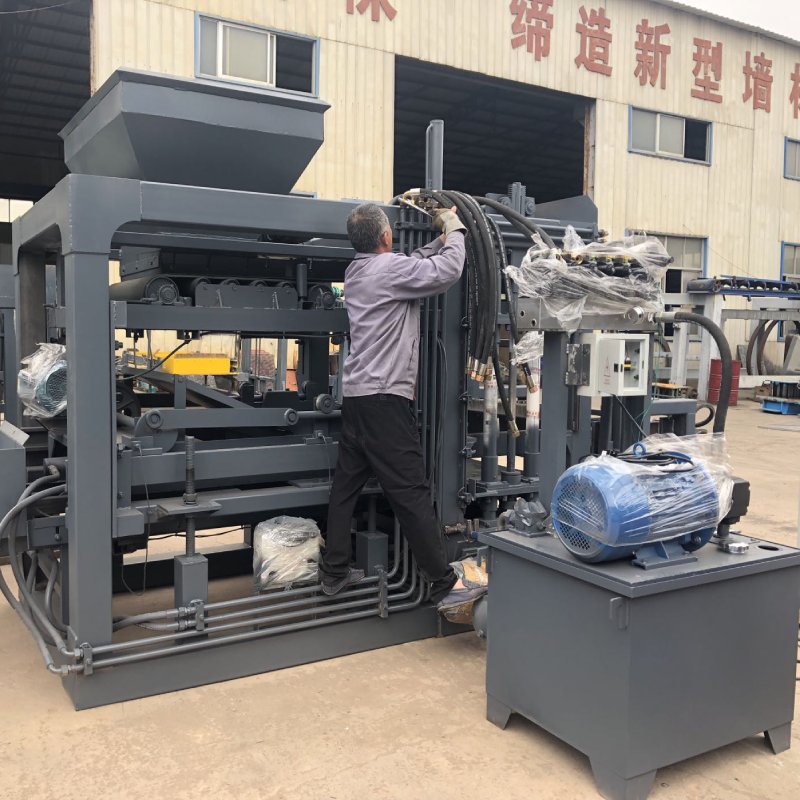
Image source Aiwei Block machine
Human-Robot Partnership Enhances Productivity in Block Brick Manufacturing
Introduction
In the landscape of modern manufacturing, the synergy between humans and robots has emerged as a transformative force, revolutionizing industries across the board. Block brick manufacturing, a cornerstone of the construction sector, is no exception. The integration of robotics and automation technology into this age-old process has given rise to a new paradigm: human-robot partnership. This article delves into the concept of human-robot collaboration in block brick manufacturing, exploring the benefits, advancements, challenges, and the profound impact this partnership is having on productivity, quality, and the future of the construction industry.
The Role of Robotics in Manufacturing
The infusion of robotics into manufacturing processes has redefined the efficiency, precision, and scalability of production. Robotics, coupled with advanced automation, has revolutionized industries by streamlining operations, enhancing product quality, and reducing human intervention in repetitive and labor-intensive tasks.
The Emergence of Human-Robot Collaboration
Human-robot collaboration (HRC) signifies a paradigm shift from traditional industrial robotics, where robots operated independently, to a scenario where humans and robots work harmoniously side by side. This collaborative approach leverages the unique strengths of both humans and robots, resulting in a symbiotic partnership that enhances productivity and optimizes task allocation.
Benefits of Human-Robot Collaboration in Block Brick Manufacturing
- Enhanced Productivity: Robots excel in repetitive and precise tasks, such as brick stacking and transportation, while humans excel in decision-making and adaptability. The partnership capitalizes on these strengths to boost overall productivity.
- Quality Assurance: Robots execute tasks with consistent precision, reducing the chances of human errors. This leads to a higher quality of bricks and ultimately results in structurally sound buildings.
- Labor Optimization: By delegating physically demanding or monotonous tasks to robots, human workers can focus on tasks that require creativity, problem-solving, and decision-making.
- Efficient Resource Utilization: HRC ensures that both human and robot resources are utilized optimally, eliminating idle time and maximizing the potential of each.
- Safety Enhancement: Robots can handle hazardous or heavy tasks that might pose risks to human workers, thereby improving overall workplace safety.
Technological Advancements in HRC for Block Brick Manufacturing
- Sensor Integration: Robots equipped with sensors can detect the presence of humans, enabling safe and efficient coexistence in shared workspaces.
- Machine Learning and AI: Advanced algorithms allow robots to learn from human operators, adapt to changing tasks, and even predict maintenance needs.
- Collaborative Robotic Design: Robots with lightweight structures and soft exteriors are designed to work alongside humans without causing harm, even in close proximity.
- Task Allocation Algorithms: Efficient algorithms distribute tasks between humans and robots based on their capabilities, optimizing productivity and minimizing idle time.
Implementation Scenarios in Block Brick Manufacturing
- Brick Loading and Unloading: Robots can efficiently load raw materials into the brick-making machine and unload finished bricks, minimizing manual labor.
- Brick Stacking: Robots can stack freshly manufactured bricks, ensuring uniformity and precision in arrangement, reducing the risk of damage.
- Quality Inspection: Robots equipped with vision systems can perform quality checks on bricks, identifying defects with high accuracy.
- Transportation: Robots can transport bricks within the manufacturing facility, streamlining the flow of materials and reducing human effort.
Challenges and Considerations
- Cost and Investment: The initial cost of implementing robotic systems can be significant, including the expense of robotic equipment and the necessary infrastructure.
- Technical Expertise: Integrating and maintaining robotic systems requires skilled technicians and engineers who are proficient in both automation and construction processes.
- Change Management: The introduction of robots might require training for the existing workforce and a shift in work culture.
The Road Ahead: Transforming the Construction Industry
The partnership between humans and robots in block brick manufacturing marks a milestone in the construction industry’s journey towards innovation. As the construction sector embraces Industry 4.0 principles, HRC serves as a testament to the industry’s commitment to efficiency, quality, and sustainable practices. The dynamic interplay between human creativity and robotic precision opens doors to unprecedented possibilities, from faster construction timelines to increased customization and better resource allocation. By embracing the potential of human-robot collaboration, the construction industry paves the way for a future where man and machine coexist synergistically, elevating productivity, ensuring quality, and constructing a more efficient and sustainable built environment.
